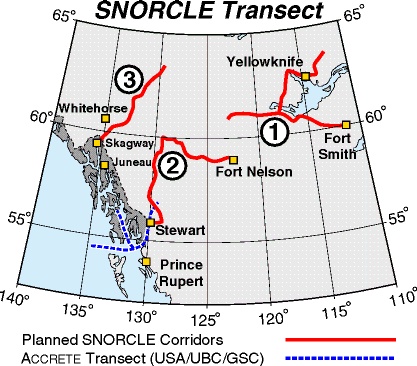In northwestern Canada, geological features
extending from the regoin of Great Slave Lake westward to the
Canada-United States border in the Alaskan "panhandle" provide
an opportunity to investigate how continental lithosphere was
constructed and modified during four billion years of Earth
history. This is the only region on Earth where such a study
is possible. The Early Archean Slave craton, located in the
western Northwest Territories, comprises the oldest known crust
on Earth (4,000 Ma) and differes significantly from the Middle
to Late Archean Superior craton in its internal structure,
in its constituent rock types, and in its contact with bordering
Proterozoic orogenic belts. Bordering the Slav craton on the
west and south are Proterozoic features having ages ranging
from ~2100-1100 Ma. Investigating the nature, geometry and
age relationships of these features and the transition from
Archean crust to the progressively younger Proterozoic orogens
represents a major scientific endeavour of international import.
Included in these investigations are a probably Proterozoic
crustal scale transform fault (the Great Slave Lake shear zone)
and a Middle Proterozoic deformation belt (Racklan orogen),
buried beneath the Phanerozoic strata, which provides a link
with the eastern Cordilleran orogeny.
 The scientific programs in two study corridors will invesigate
the architecture of the northern Cordilleran orogen with
the aim of unravelling the complex succession of accretionary
events and the subsequent dispersal of terranes by orogen-parallel
strike-slip deformation. They also will address the question
of why the 2500 km-long foreland basin of the Cordilleran
orogen is much more extensive, both areally and vertically,
in the south than in the north. The petroleum industry has
expressed interest in basin portions of the transect and
has recorded a number of deep crustal profiles in northeastern
BC. Included in the scientific investigations are: The scientific programs in two study corridors will invesigate
the architecture of the northern Cordilleran orogen with
the aim of unravelling the complex succession of accretionary
events and the subsequent dispersal of terranes by orogen-parallel
strike-slip deformation. They also will address the question
of why the 2500 km-long foreland basin of the Cordilleran
orogen is much more extensive, both areally and vertically,
in the south than in the north. The petroleum industry has
expressed interest in basin portions of the transect and
has recorded a number of deep crustal profiles in northeastern
BC. Included in the scientific investigations are:
- the geometry and nature of the welding of the young accreted
crust to the Precambrian craton in an area unaffected by
post-accretionary extension;
- characterization of the many exotic terranes, their boundaries
and their interrelationships;
- detailed studies in two locations of the geometry and
characteristics of the Tintina fault, a major intracontinental
transform
fault with dextral strike-slip motion of at least several
hundred
kilometers
The planned SNORCLE Corridor 2 links with the active
US-based ACCRETE program, thus creating the potential
for a near-continuous,
multidisciplinary transect to extend from the oldest
crust on Earth to the Pacific plate. (Map
of ACCRETE transect)
Publications
Transect Reports |
